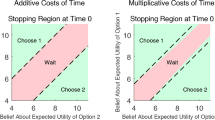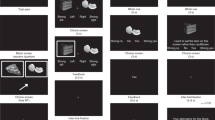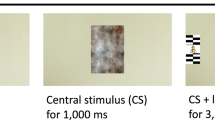Abstract
Toddlers exhibit behaviours that suggest judicious responses to states of uncertainty (for example, turning to adults for help), but little is known about the informational basis of these behaviours. Across two experiments, of which experiment 2 was a preregistered replication, 160 toddlers (aged 25 to 32 months) identified a target from two partially occluded similar (for example, elephant versus bear) or dissimilar (for example, elephant versus broccoli) images. Accuracy was lower for the similar trials than for the dissimilar trials. By fitting drift–diffusion models to response times, we found that toddlers accumulated evidence more slowly but required less evidence for similar trials compared with dissimilar trials. By analysing eye movements, we found that toddlers took longer to settle on the selected image during inaccurate trials and switched their gaze between response options more frequently during inaccurate trials and accurately identified similar items. Exploratory analyses revealed that the evidence-accumulation parameter correlated positively with the use of uncertainty language. Overall, these findings inform theories on the emergence of evidence accumulation under uncertainty.
This is a preview of subscription content, access via your institution
Access options
Access Nature and 54 other Nature Portfolio journals
Get Nature+, our best-value online-access subscription
$29.99 / 30 days
cancel any time
Subscribe to this journal
Receive 12 digital issues and online access to articles
$119.00 per year
only $9.92 per issue
Buy this article
- Purchase on Springer Link
- Instant access to full article PDF
Prices may be subject to local taxes which are calculated during checkout





Similar content being viewed by others
Data availability
The datasets generated and analysed during the current studies are available at the Open Science Framework repository (https://osf.io/t8p4g/).
Code availability
The code generated and used during the current studies are available at the Open Science Framework repository (https://osf.io/t8p4g/).
References
Coughlin, C., Hembacher, E., Lyons, K. E. & Ghetti, S. Introspection on uncertainty and judicious help‐seeking during the preschool years. Dev. Sci. 18, 957–971 (2015).
Jaswal, V. K., Croft, A. C., Setia, A. R. & Cole, C. A. Young children have a specific, highly robust bias to trust testimony. Psychol. Sci. 21, 1541–1547 (2010).
Schulz, L. E. & Bonawitz, E. B. Serious fun: preschoolers engage in more exploratory play when evidence is confounded. Dev. Psychol. 43, 1045–1050 (2007).
Stahl, A. E. & Feigenson, L. Observing the unexpected enhances infants’ learning and exploration. Science 348, 91–94 (2015).
Balcomb, F. K. & Gerken, L. Three‐year‐old children can access their own memory to guide responses on a visual matching task. Dev. Sci. 11, 750–760 (2008).
Lyons, K. E. & Ghetti, S. The development of uncertainty monitoring in early childhood. Child Dev. 82, 1778–1787 (2011).
Nelson, T. O. & Narens, L. in Metacognition: Knowing About Knowing vol. 13 (eds Metcalfe, J. & Shimamura, A. P.) 1–25 (MIT Press, 1994).
Dehaene, S., Lau, H. & Kouider, S. What is consciousness, and could machines have it? Science 358, 486–492 (2017).
Hampton, R. R. Multiple demonstrations of metacognition in nonhumans: converging evidence or multiple mechanisms? Comp. Cogn. Behav. Rev. 4, 17–28 (2009).
Smith, J. D. & Washburn, D. A. Uncertainty monitoring and metacognition by animals. Curr. Dir. Psychol. Sci. 14, 19–24 (2005).
Metcalfe, J. in Handbook of Metamemory and Memory (eds Dunlosky, J. & Bjork, R. A.) 29–46 (Psychology Press, 2008).
Goupil, L., Romand-Monnier, M. & Kouider, S. Infants ask for help when they know they don’t know. Proc. Natl Acad. Sci. USA 113, 3492–3496 (2016).
Goupil, L. & Kouider, S. Behavioral and neural indices of metacognitive sensitivity in preverbal infants. Curr. Biol. 26, 3038–3045 (2016).
Desender, K., Boldt, A. & Yeung, N. Subjective confidence predicts information seeking in decision making. Psychol. Sci. 29, 761–778 (2018).
Fandakova, Y. et al. Changes in ventromedial prefrontal and insular cortex support the development of metamemory from childhood into adolescence. Proc. Natl Acad. Sci. USA 114, 7582–7587 (2017).
Ratcliff, R. & McKoon, G. The diffusion decision model: theory and data for two choice decision tasks. Neural Comput. 20, 873–922 (2008).
Roderer, T. & Roebers, C. M. Can you see me thinking (about my answers)? Using eye-tracking to illuminate developmental differences in monitoring and control skills and their relation to performance. Metacogn. Learn. 9, 1–23 (2014).
Folke, T., Jacobsen, C., Fleming, S. M. & De Martino, B. Explicit representation of confidence informs future value-based decisions. Nat. Hum. Behav. 1, 0002 (2016).
Ackerman, R. & Koriat, A. Response latency as a predictor of the accuracy of children’s reports. J. Exp. Psychol. Appl. 17, 406–417 (2011).
Lyons, K. E. & Ghetti, S. I don’t want to pick! Introspection on uncertainty supports early strategic behavior. Child Dev. 84, 726–736 (2013).
Pleskac, T. J. & Busemeyer, J. R. Two-stage dynamic signal detection: a theory of choice, decision time, and confidence. Psychol. Rev. 117, 864–901 (2010).
Heitz, R. P. The speed-accuracy tradeoff: history, physiology, methodology, and behavior. Front. Neurosci. 8, 150 (2014).
Ratcliff, R., Gomez, P. & McKoon, G. A diffusion model account of the lexical decision task. Psychol. Rev. 111, 159–182 (2004).
Metin, B. et al. ADHD performance reflects inefficient but not impulsive information processing: a diffusion model analysis. Neuropsychology 27, 193–200 (2013).
Mulder, M. J. et al. Basic impairments in regulating the speed-accuracy tradeoff predict symptoms of attention-deficit/hyperactivity disorder. Biol. Psychiatry 68, 1114–1119 (2010).
Ratcliff, R., Love, J., Thompson, C. A. & Opfer, J. E. Children are not like older adults: a diffusion model analysis of developmental changes in speeded responses. Child Dev. 83, 367–381 (2012).
Roderer, T. & Roebers, C. M. Explicit and implicit confidence judgments and developmental differences in metamemory: an eye-tracking approach. Metacogn. Learn. 5, 229–250 (2010).
Gehring, W. J., Coles, M. G., Meyer, D. E. & Donchin, E. A brain potential manifestation of error-related processing. Electroencephalogr. Clin. Neurophysiol. Suppl. 44, 261–272 (1995).
Aitken, P. P. & Hutt, C. The effects of stimulus incongruity upon children’s attention, choice, and expressed preference. J. Exp. Child Psychol. 19, 79–87 (1975).
Lerche, V., Voss, A. & Nagler, M. How many trials are required for parameter estimation in diffusion modeling? A comparison of different optimization criteria. Behav. Res. Methods 49, 513–537 (2017).
Harris, P. L., Bartz, D. T. & Rowe, M. L. Young children communicate their ignorance and ask questions. Proc. Natl Acad. Sci. USA 114, 7884–7891 (2017).
Vandekerckhove, J., Tuerlinckx, F. & Lee, M. D. Hierarchical diffusion models for two choice response times. Psychol. Methods 16, 44–62 (2011).
Goupil, L. & Kouider, S. Developing a reflective mind: from core metacognition to explicit self-reflection. Curr. Dir. Psychol. Sci. 28, 403–408 (2019).
Arias-Trejo, N. & Plunkett, K. The effects of perceptual similarity and category membership on early word-referent identification. J. Exp. Child Psychol. 105, 63–80 (2010).
Geurten, M. & Bastin, C. Behaviors speak louder than explicit reports: implicit metacognition in 2.5‐year‐old children. Dev. Sci. 22, e12742 (2018).
Voss, A., Rothermund, K. & Voss, J. Interpreting the parameters of the diffusion model: an empirical validation. Mem. Cogn. 32, 1206–1220 (2004).
Voss, A., Nagler, M. & Lerche, V. Diffusion models in experimental psychology: a practical introduction. Exp. Psychol. 60, 385–402 (2013).
Koriat, A. & Ackerman, R. Choice latency as a cue for children’s subjective confidence in the correctness of their answers. Dev. Sci. 13, 441–453 (2010).
Carruthers, P. Basic questions. Mind Lang. 33, 130–147 (2018).
Urgolites, Z. J., Smith, C. N. & Squire, L. R. Eye movements support the link between conscious memory and medial temporal lobe function. Proc. Natl Acad. Sci. USA 115, 7599–7604 (2018).
Fleming, S. M. & Daw, N. D. Self-evaluation of decision-making: a general Bayesian framework for metacognitive computation. Psychol. Rev. 124, 91–114 (2017).
Yeung, N. & Summerfield, C. Metacognition in human decision-making: confidence and error monitoring. Philos. Trans. R. Soc. B 367, 1310–1321 (2012).
Yassa, M. A. et al. Pattern separation deficits associated with increased hippocampal CA3 and dentate gyrus activity in nondemented older adults. Hippocampus 21, 968–979 (2011).
Kuperman, V., Stadthagen-Gonzalez, H. & Brysbaert, M. Age-of-acquisition ratings for 30,000 English words. Behav. Res. Methods 44, 978–990 (2012).
Fenson, L. et al. Reply: measuring variability in early child language: don’t shoot the messenger. Child Dev. 71, 323–328 (2000).
Wabersich, D., & Vandekerckhove, J. The RWiener Package: an R package providing distribution functions for the Wiener diffusion model. R J. 6, 49–56 (2014).
Pinheiro, J., Bates, D., DebRoy, S., Sarkar, D. & R Core Team nlme: linear and nonlinear mixed effects models. R package version 3.1-137 https://cran.r-project.org/web/packages/nlme/nlme.pdf (2018).
Droit-Volet, S. Stop using time reproduction tasks in a comparative perspective without further analyses of the role of the motor response: the example of children. Eur. J. Cogn. Psychol. 22, 130–148 (2010).
Acknowledgements
This research was supported by a grant from the National Science Foundation (NSF; BCS1424058) to S.G. Any opinions, findings and conclusions or recommendations expressed in this manuscript are those of the authors and do not necessarily reflect the views of the NSF. The funders had no role in study design, data collection and analysis, decision to publish or preparation of the manuscript.
Author information
Authors and Affiliations
Contributions
S.G. developed the study concept. S.G., S.L. and E.H. finalized the study design. S.L. and E.H. performed data collection. S.L., D.S., A.K. and E.G.J. contributed to data analysis and interpretation under the supervision of S.G. S.L., D.S., E.H. and S.G. drafted the manuscript. All of the authors provided revisions and approved the final version of the manuscript for submission.
Corresponding authors
Ethics declarations
Competing interests
The authors declare no competing interests.
Additional information
Peer review information Primary Handling Editor: Marike Schiffer.
Publisher’s note Springer Nature remains neutral with regard to jurisdictional claims in published maps and institutional affiliations.
Extended data
Extended Data Fig. 1 Quantile plots for drift–diffusion model.
Lines with x markers are plotted based on observed data and dashed lines with o markers are the simulated data produced by our complete model in Experiment 1 (a) and Experiment 2 (b). Graphs show the .1, .3, .5 (median), .7, and .9 quantiles (stacked vertically) plotted against response proportion for each of the two conditions (dissimilar and similar). Similar/Dissimilar labels are placed at the level on x-axis corresponding to the response proportion for that type of trial. Correct response proportions are plotted to the right, and incorrect response proportions are plotted to the left. Predicted values qualitatively resemble observed values, indicating good fit of our drift–diffusion models to the data.
Extended Data Fig. 2 Response latencies and mean proportion looktime in the eye tracker task.
Mean response latencies for dissimilar-accurate, similar-accurate, and inaccurate trials for Experiment 1 (a) and Experiment 2 (c). Mean proportion looktime for the time bin prior to the average response latency for dissimilar-accurate (2–3 seconds for Experiment 1, 4-5 seconds for Experiment 2), similar-accurate (3-4 seconds for Experiment 1, 4-5 seconds for Experiment 2), and inaccurate (4-5 seconds in Experiment 1, 5-6 seconds for Experiment 2) trials for Experiment 1 (b) and Experiment 2 (d). Points represent individual data points. Data points on both graphs are jittered on the horizontal axis to avoid stacking. Error bars are 95 percent confidence intervals.
Extended Data Fig. 3 Effect of Similarity on Reaction Time Inaccurate Trials.
Multilevel model results showing the effect of similarity on reaction times for inaccurate trials for Experiment 1 (a) and Experiment 2 (b). Results displayed here are for models dummy coded relative to dissimilar-inaccurate trial type.
Extended Data Fig. 4 Looking Time Multilevel Model.
Multilevel model results for Experiment 1 (a) and Experiment 2 (b). Results displayed here are for models dummy coded relative to inaccurate trial type and time bin 1. Models were evaluated for significance with a chi-squared difference test. Both models were statistically different from an intercept only model (Experiment 1: X2 (8) = 64.45, p < .001; Experiment 2: X2 (8) = 17.87, p = .02).
Supplementary information
Supplementary Information
Supplementary Figs. 1 and 2, Supplementary Tables 1–3, results and references.
Rights and permissions
About this article
Cite this article
Leckey, S., Selmeczy, D., Kazemi, A. et al. Response latencies and eye gaze provide insight on how toddlers gather evidence under uncertainty. Nat Hum Behav 4, 928–936 (2020). https://doi.org/10.1038/s41562-020-0913-y
Received:
Accepted:
Published:
Issue Date:
DOI: https://doi.org/10.1038/s41562-020-0913-y
This article is cited by
-
Motivating children to (pre)monitor: positive effects on monitoring accuracy?
Metacognition and Learning (2024)



